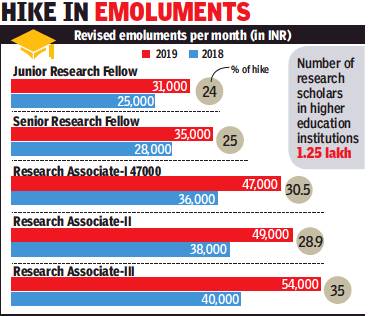Research scholars in science and technology: India
This is a collection of articles archived for the excellence of their content. |
Contents |
Fellowship emoluments
2018, 2019
24-35% hike in scholars’ fellowship stipends, January 31, 2019: The Times of India

From: 24-35% hike in scholars’ fellowship stipends, January 31, 2019: The Times of India
Science & Tech Researchers To Get Raise From Jan 1
The government announced a 24-35% hike in fellowship stipend for research scholars in science and technology with effect from January 1 this year, a move that will directly benefit 60,000 researchers.
As per the office memorandum issued by the ministry of science and technology, a Junior Research Fellow (JRF) will now get Rs 31,000 per month as against the earlier Rs 25,000 while fellowship for Senior Research Fellow (SRF) has been hiked from Rs 28,000 to Rs 35,000.
A total of 1.25 lakh researchers are likely to benefit. “PhD scholars working in science and technology are the most significant contributors to the knowledge base of the country for its industrial competitiveness, academic vibrancy and technology led innovations. With effect from January 1, 2019, central government has enhanced the fellowship of PhD students and other research personnel enrolled in any area of science and technology, including physical and chemical sciences, engineering, mathematical sciences, agricultural sciences, life sciences, pharmacy, among others,” the government said.
JRF and SRF are taken as baseline reference for hike in emoluments for researchers and compared to last four hikes this has been the lowest. Scholars are unhappy at the “low hike”.
The revised emoluments has been increased by Rs 6,000 per month for JRF and Rs 7,000 per month for SRF. In 2006, the JRFs were hiked by 60%, followed by 50% in 2007. In 2010, the hike was around 33% and it was 56% in 2014.
Open access work published by Indians
2020
Hemali Chhapia, Nov 29, 2023: The Times of India
Desi researchers spent $17m in ’20 to publish ‘open access’ work, over 50% of global total
Mumbai : Indian researchers shelled out $17 million in 2020 to publish their work and keep it as open access. Cumulatively, around $30 million was spent by researchers globally, reflecting that India’s spend was more than half in that year.
Termed as Article Processing Charges (APCs), this fee ensures the financial viability of open access (OA) scholarly journals. A research paper by Raj Kishor Kampa from the department of Library and Information Science, Berhampur University; Manoj Kumar Sa from the Indian Maritime University, Kolkata and Mallikarjun Dora from the Vikram Sarabhai Library, Indian Institute of Management, Ahmedabad, found that Indian researchers published 26,127 gold OA articles across all subjects in WoS (Web of Science)-indexed journals in 2020.
Researchers in the field of health and medical sciences paid the highest APC, amounting to $7 million, followed by life and earth sciences ($6.9 million), multidisciplinary ($4.9 million), and chemistry and materials science ($4.8 million). In all, 81% of APCs went to commercial publishers such as MDPI, Springer–Nature, Elsevier and Frontier Media. MDPI was the top publisher where Indian researchers published their articles. It published around 2,360 articles in its 143 flagship journals. The total APC of these 2,360 articles was about half-amillion USdollars.
According to an analysis of APCs across fields, it was found that science, technology, engineering and mathematics (STEM) journals had a higher APC than those in social science and humanities. Particularly, high APC is found in subjects like biology, chemistry and medicine.
“The primary issue for Indian researchers is that there is no dedicated system for funding OA publications and no nationwide OA mandate like in many other countries,” the authors said in their study published in the recent issue of Current Science. They suggested the formulation of national-level OA policies since OA is “inevitable for equity and access to scholarly communications”.
Private publishers charge asubscription fee or place articles behind a paywall, which makes research work inaccessible to many. However, OA literature is largely freely accessible online. The suggestion was made after examining the rise of the OA method adopted by India researchers.
Picture this: In 2011, there were 14,850 OA publications, with 5,864 being gold OA. By 2020, the total number of OA publications had increased to 50,662, with 30,604 being gold OA and 20,058 other OA publications. Also, the number of journals levying APCs has grown consistently: it was 1,825 in 2011 and 5,661 in 2022. The authors felt that with the growing number of OA publications from India, a central and state-level single-window option for funding in OA journals would help researchers.